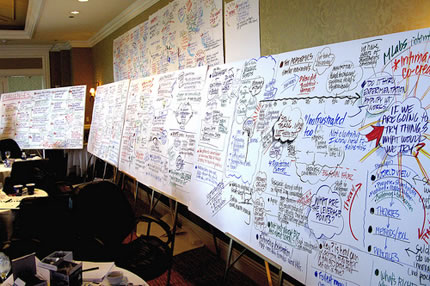Customer Service Improvement – The First Step
 Over and over we see customer service initiatives stall because of impatience. The key players involved in the improvement process take on too much at one time, overwhelming themselves as well as the organization. Everyone ends up frustrated, the initiative is abandoned, and employees are rightly skeptical of subsequent initiatives.
Over and over we see customer service initiatives stall because of impatience. The key players involved in the improvement process take on too much at one time, overwhelming themselves as well as the organization. Everyone ends up frustrated, the initiative is abandoned, and employees are rightly skeptical of subsequent initiatives.
A planned, step-by-step approach dramatically increases the likelihood of success of a service improvement initiative. Most organizations should plan on 2-5 years before feeling that the elements of the service initiative are “inculturated.” While that may seem an unreasonably long time, the reality is that the organization’s current culture took years to evolve and expecting instantaneous change is simply unrealistic.
In practice, once management agrees a change is needed, they want the change to happen right now, with no fuss. But change with no fuss is probably no change at all – at least not one that is going to result in a significant improvement. Real change has moments of confusion, pain, doubt, argument and even tears. Letting go of the “old way” is never easy. And the more angst the change is causing, the more likely the change is needed. Complacency in today’s marketplace can be fatal to an organization.
Take the time to plan each phase of the initiative, following the chapters of Unleashing Excellence as a guide. While the chapters aren’t strictly linear, they’re pretty close. Do the work of each of the Leadership Actions in the order presented; you’ll be rewarded by an improvement initiative that actually results in improvement.
Innovation Stimulation
 Today’s Wall Street Journal has an interesting article, “Entrepreneurs Seek to Elicit Workers’ Ideas.” The premise of the article is that a company’s employees are often a vast and untapped reservoir of ideas for improving the business. One company CEO is quoted as saying, “Wow, we have a lot of smart people back here, and we’re not tapping their knowledge.”
Today’s Wall Street Journal has an interesting article, “Entrepreneurs Seek to Elicit Workers’ Ideas.” The premise of the article is that a company’s employees are often a vast and untapped reservoir of ideas for improving the business. One company CEO is quoted as saying, “Wow, we have a lot of smart people back here, and we’re not tapping their knowledge.”
We heartily agree.
A company’s employees deal with the same challenges, issues, and complaints day in and day out and typically know exactly what ticks off customers. The problem is that many organizations simply don’t ask their employees to help identify and solve the issues. Or they do ask (because the employee survey said that management never asks for input) but never take action on the suggestions. Which is too bad, since our experience shows that employee solutions are usually MUCH less expensive than management’s solutions.
The one quibble we have with the WSJ article is the bias for offering cash incentives for submitting ideas – $50 per implemented idea; $100 for 100 innovative ideas, etc. We like money as much as anyone, but we believe that improving the organization should be part of the organization’s culture and participating in the forward movement of the company should simply be part of the job description.
We’ve seen many organizations implement a “bounty” for ideas only to find that employees begin hording ideas out of fear that someone will steal them for the bounty, or become enraged that “Joan got $50 for her stupid idea, and I got nothin’ for my great idea.” And how about the employee who gets $50 for an idea that saves the company $10 million? Trust us; someone is going to feel shortchanged.
Check out the WSJ article, but also know that we feel collaboration is the name of the innovation game. The Service Obstacle System described in Unleashing Excellence provides several tools for getting your employees involved in identifying and eliminating (or alleviating) barriers to excellence. The Continuous Service Improvement Meeting Agenda is a good place to start.
Do your employees view innovation as a part of their jobs?
